













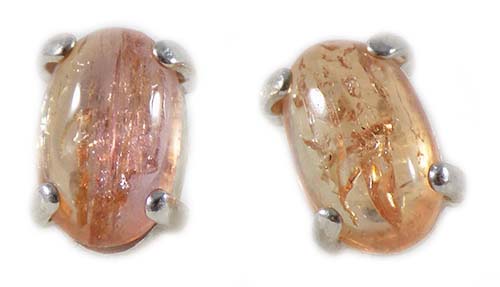
Two Antique Genuine Natural Russian Handcrafted Orange-Yellow Imperial Topaz Oval Cabochons. Mounted into contemporary high quality sterling silver studs.
ORIGIN: The Ural Mountains, Russia. 19th Century.
CLASSIFICATION: Antique Cut Faceted Imperial Topaz.
SIZE: Length: 12mm. Width: 7mm. Depth: 6mm. All measurements approximate.
WEIGHT: 7.25 carats.
NOTE: These earring settings are also available in solid 14kt gold. Other setting styles (euro clicks, lever backs, kidney wires, ball/stud dangles) are available upon request, both in sterling silver, as well as 14kt solid gold and in 14kt gold fill.
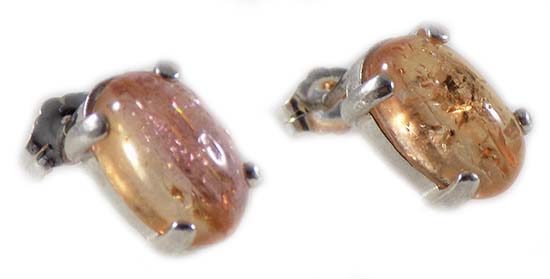
DETAIL: A pair of gorgeous, richly colored orange-yellow natural “imperial” topaz cabs from the Ural Mountains of Russia. Gorgeous, vibrant, vivid and richly hued these striking semi-precious gemstones are of nice quality and possess breathtaking luster. The rich texture and hue really brings to mind Baltic amber. You'll notice very distinctive "lines" or "needles" within the gemstones, sparkly, which are typically described as "rutile", and were believed to be composed of quartz crystalline material. While through the 19th and 20th centuries these "needles" were believed to be titanium oxide "rutile" needles, recently they have proven to actually be a mineral known as "limonite". Titanium rutile needles do occur in an uncommon form of quartz (known as "rutilated quartz"), but despite the similarity, technically, these "needles" are not rutile.
Nonetheless in the trade this particular gemstone (subspecies) is still referred to as "rutilated imperial topaz", so keeping with tradition, we'll follow custom and describe it as "rutilated imperial topaz". Some might regard rutile "needles" as a "blemish", nonetheless they do make for a very distinctive and uncommon gemstone. On the other hand, rutile oftentimes enhances the value of gemstones, as in the titanium rutile inclusions within quartz crystal.
The gemstones were hand finished by a 19th century artisan into these beautiful oval cabochons, originally intended for us in indigenous jewelry. Fabled Czarist Russia was of course known throughout the Renaissance and Victorian worlds for elaborate and costly jewelry. By today’s standards these are not exceptionally high quality gemstones, as explained above. Though distinctive, the rutile quartz crystalline "strands" are technically considered a blemish. In these 500% photo enlargements you can see many of these "filaments", or "needles". Of course in hand, it is simply a very pleasingly color orange-yellow gemstone – and these blemishes to the naked eye are not immediately discerned by the casual admirer, though once pointed out, they are quite distinctive. And by nineteenth century standards these were fabulously expensive gemstones, the exclusive domain of royalty. Certainly they were owned by no less than someone of noble or even royal birth.
Russian Imperial Topaz, also known as “precious topaz”, is a very rare naturally colored gemstone, the most costly variety of topaz. The color ranges from yellow to orange, pink and peach to purple, and occasionally even red. Most pink imperial topaz is produced by heating yellow or orange imperial topaz. Discovered in the 19th century in the Ural Mountains of Russia, together with alexandrite, it was mined and produced exclusively for the royal family. By imperial decree only the Czars of Russia were permitted to own or to gift this rare gemstone. With the revolution in 1917 came a total export ban on imperial topaz – it was not until post-Soviet Russia that a small amount of imperial topaz was exported from Russia in the 1990’s. By the year 2000, the mines were played out and abandoned.
Today imperial topaz is mined in Brazil, and some very small quantities in Afghanistan and Sri Lanka (Ceylon). Even the imperial topaz mined in Brazil, Sri Lanka, and Afghanistan is expensive – prices of $1,000 per carat are not unusual. But Russia Imperial Topaz is gone, available in limited quantities here and there, typically in the form of antique gemstones. The earring settings are of contemporary origin. They are high quality settings manufactured by one of the USA’s leading semi-custom mount producers. They are constructed of sterling silver; they are not cheap, silver electroplated earrings. It is genuine sterling silver, designed to last a lifetime. It's a first-class piece of jewelry throughout. We can reset in 14kt solid gold or 14kt gold fill upon request, and there are also many other setting styles available upon request.
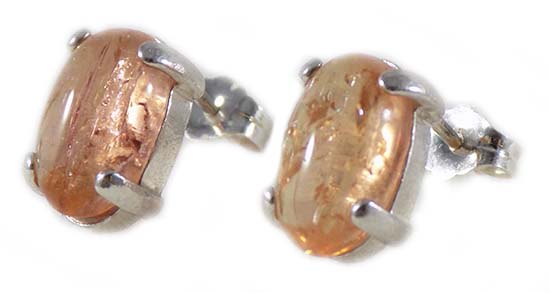
Though the Southern Ural Mountains of Russia have been producing topaz for centuries, this remains nonetheless a rare and uncommon gemstone. . Under magnification these gemstones show the unmistakable characteristics of having been hand crafted. The coarseness of the 19th century finish is considered appealing to most gemstone collectors, and is not considered a detriment, and does not detract from the value of a gemstone. These characteristics are not only expected of hand-finished gemstones, most serious collectors consider such gemstones more desirable, possessed of greater character and uniqueness when compared to today's cookie-cutter mass-produced machine-tumbled gemstones. Unlike today’s computer controlled machine produced gemstones, the cut and finish of a gemstone such as this is the legacy of an artisan who lived two centuries ago. The gemstones possess great luster and sparkle, wonderful color and texture, and to the eye are more or less transparent; but the gemstones are not flawless. They could not even be characterized as exceptionally high quality. In fact, they are quite typical of 19th century gemstones both in quality and finish. Keep in mind however that magnified 500%, as they are here, you can see every minor imperfections (included material) within the gemstones and irregularity in the finish.
These characteristics are not only expected of hand-finished gemstones, you must also consider that two centuries ago the mining techniques even possible then, let alone in practice, did not allow the ultra deep mining operations which are so commonplace today. Two centuries ago mankind was more or less limited to surface deposits or near surface deposits of gemstones. Higher quality gemstones which today are routinely mined from beneath hundreds of meters, even kilometers beneath the earth's surface, were simply inaccessible then. So antique gemstones must be appreciated as antiques first, gemstones second. The relatively superlative quality of contemporary gemstones routinely mined from deep beneath the earth's surface today were simply not accessible two centuries ago, or at least, only rarely so. However for most, the unique nature and character of antique gemstones such as these more than makes up for included imperfections which by and large, are only visible under high magnification. In hand these are very pleasing gemstones, and the blemishes really only noticeable upon close scrutiny.

HISTORY OF TOPAZ: It is believed that topaz was known during the early Bronze Age, as the mining of topaz is strongly associated with tin mining, a mineral needed to create bronze (an alloy of copper and tin). Archaeologists are certain that the people in the Middle-Eastern Bronze Age would have known about this gemstone. However the first historical descriptions of topaz were from the classical Mediterranean. The origin of topaz in the ancient Mediterranean was a small island in the Red Sea known as “Topazion”, a Greek term meaning “to guess”. In Arabic the same term means “"the subject of the search". This reflects the fact that the island was typically obscured by fog, making it difficult for early navigators to find. Typically yellow, topaz in the ancient world was held as a talisman to protect against evil and was used to treat many different physical ailments including asthma.
The Greeks and Romans greatly valued topaz as a gemstone, even believing that the gemstone would improve the wearer’s eyesight. Ancient Romans also credited topaz with preventing sickness of the chest and it was also used to treat abdominal pain. The ancient Greeks believed topaz would give great strength to whomsoever wore the stone, and was also worn as an amulet to ward off enchantment (“spells” or “curses”). The ancient Greeks also believed that wearing topaz would dispel sadness and strengthen the wearer’s intellect. There are also frequent references from ancient Greek sources which claim that wearing topaz rendered the wearer invisible.
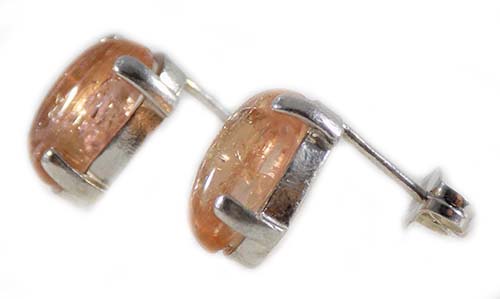
In Rome and the Early Medieval world, topaz was associated with Apollo and/or Jupiter, as Topaz was associated with the sun, and both Jupiter and Apollo were solar deities. Both Julius Caesar and his heir Octavian Augustus held Apollo in special reverence. Augustus credited Apollo with his victory over Marc Antony, and erected a magnificent temple to Apollo at Actium overlooking the site of the famous naval battle, as well as an even grander temple on the Palatine in Rome. The gemstone was also described by the first century Roman historian and naturalist “Pliny the Elder”.
There are also many biblical references to "topaz". Topaz was one of the twelve stones selected by Aaron for his priestly breastplate, representing the twelve tribes of ancient Israel. He placed it there as the second stone in the first row of stones. Topaz is also found as one of the stones in the book of Revelations as one of the stones of the apocalypse (one of the gemstones which form the foundations of the twelve gates to the Holy City of the New Jerusalem). To ancient Christians topaz was regarded as a symbol of uprightness and virtue. In ancient Egypt the golden glow of yellow topaz symbolized "Ra", their sun god. This made topaz a very powerful amulet that protected the faithful against harm. In ancient India topaz was regarded as a sacred gemstone. Ancient Hindus believe that worn as a pendant above the heart topaz assured long life, beauty and intelligence (and would also alleviate thirst).

In the latter Middle Ages small wine-yellow Saxonian Topaz were mined at Schneckenstein in the Erzgebirge Mountains in Saxony, Germany, and several rulers wore these specimens in jewelry. The Germans believed that the yellow topaz prevented bad dreams, calmed passions, ensured faithfulness and, when taken in wine, cured asthma and insomnia. It was also believed that the figure of a falcon engraved upon a topaz talisman would bring the wearer the goodwill and kindness of the gods. Wearing topaz in a ring was believed to lengthen one’s life and forestall death (or alternatively to prevent sudden death). Worn around the neck, topaz was also thought to cure madness. If also mounted in gold and worn around the neck, it was believed to dispel enchantments and calm nocturnal fears.
Worn as a protective talisman topaz was said to instantly lose its color to indicate that poisoned food or drink was present, thus protecting its owner. It was also believed to be an effective talisman against accidents. Topaz was also regarded as a talisman for travelers, protecting them from homesickness and danger. In the Medieval World, it was believed that wearing a topaz talisman conferred to the wearer special powers over animals. Topaz was also used by shamans and seers who believed that topaz and encouraged clairvoyance and psychic skills, and enabled the wearer to perceive the intentions and motives of the people around them. It was also believed to make men handsome and intelligent and sterile women fertile and happy. There were as well medicinal uses for topaz in the Middle Ages. Topaz was believed to be able to actually absorb the heat of a fever. Topaz was also believed to ease the inflammations, discomfort and pain associated with arthritis. However the curative powers of topaz were believed to weaken and strengthen in response to changing phases of the moon.
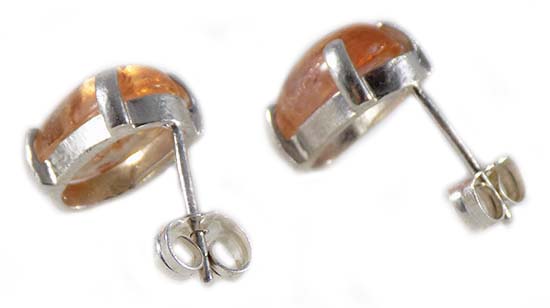
Topaz is found in yellow, orange, green, blue, red, and white (colorless) hues. The highest grade topaz comes from Sri Lanka and India, the Ural Mountains in Russia, Brazil, and in the U.S.; from Maine, Colorado, California, and Utah. The most popular color for topaz gemstones is light blue, and the most costly is a rich orange-yellow, resembling the color of sherry wine, known as “imperial” topaz (sometimes referred to as “precious topaz”). Sherry-colored topaz is called “imperial” topaz in honor of the Russian Tsar who owned the mining fields of topaz in the Urals Mountain range (in Siberia, Russia), and the best quality topaz were reserved for the emperor and his family. Topaz is one of the hardest minerals in nature, and for that reason, highly valued as a gemstone.
Throughout the history of the ancient world, gemstones were believed capable of curing illness and providing protection. Found in Egypt dated 1500 B. C., the "Papyrus Ebers" offered one of most complete therapeutic manuscripts containing prescriptions using gemstones and minerals. Gemstones were not only valued for their medicinal and protective properties, but also for educational and spiritual enhancement. In the ancient world topaz was thought to heal both physical and mental disorders, and to prevent death. Topaz was also believed to assure beauty, fidelity and long life. Topaz was also used to treat medical ailments. Topaz powdered and drunk in wine, cured asthma, tuberculosis, insomnia, burns and hemorrhages. The twelfth century German Prophetess/Visionary Mystic/Catholic Saint "Hildegard" had an unusual prescription for improving failing vision which involved soaking a topaz in wine, then rubbing the eyes with the gemstone and drinking the wine.
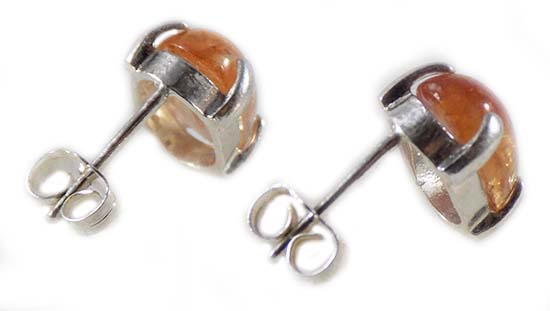
Topaz was also regarded effective against bleeding and heart disease, as well as a cure for rheumatism, gout, and soreness in the joints. Wearing topaz was believed to aid the spinal column and help steady and regulate the action of the heart. It was used to treat bleeding and believed helpful to promote health in the glandular systems of the body. It was also believed to improve eyesight. Topaz was also used in treating infections, deafness, goiter, hemorrhage, circulatory problems, digestive problems, combating anorexia, restoring the sense of taste, stimulating metabolism and more. I was regarded as especially effective in treating hemorrhoids if it were worn on the left arm. Last (but certainly not least), men were believed to become more virile when wearing topaz! On the metaphysical plane, the ancient world regarded topaz as a stone of true love and capable of attracting success in all endeavors. Topaz was believed to promote creativity and individuality, and was thought excellent for promoting concentration. It was also attributed with the power to replace negativity with love and joy, stimulating a brighter outlook on life.
Topaz was also known as the “lover of gold,” as it is used to bring wealth and money. It is traditionally known as a stone of love and good fortune, bringing successful attainment of goals. It was said to be especially effective when set in gold and bound to the left arm. When worn as an amulet, topaz drove away sadness, added intelligence and gave courage. On the emotional plane, topaz was believed to be useful for treating depression. It was believed to help people alleviate their fears, and was used to treat psychosomatic illnesses. It was regarded as useful in balancing emotions, helping those who go from one extreme to another. Topaz was also highly recommended for healing a person who was suffering from shock or trauma, and was regarded as a panacea for those whose lives contained abnormal amounts of stress or tension. In particular, blue topaz was believed extremely helpful to those who were angry. Blue topaz was regarded as possessing the power of the moon and elemental water. Blue topaz was believed effective in helping the wearer to release their anger, and to bring one’s emotional pain to the surface. Modern practitioners believe that topaz assists in general tissue regeneration and in the treatment of hemorrhages. It also believed to stimulate poor appetite and aid in the treatment of blood disorders. In India topaz is still used to treat tonsillitis, whooping cough, and mumps.
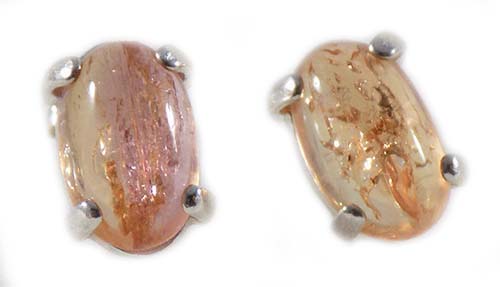 SHIPPING & RETURNS/REFUNDS: Your purchase will ordinarily be shipped within 48 hours of payment. We package as well as anyone in the business, with lots of protective padding and containers. All of our shipments are fully insured against loss, and our shipping rates include the cost of this coverage (through stamps.com, Shipsaver.com, the USPS, UPS, or Fed-Ex). International tracking is provided free by the USPS for certain countries, other countries are at additional cost. ADDITIONAL PURCHASES do receive a VERY LARGE discount, typically about $5 per item so as to reward you for the economies of combined shipping/insurance costs. We do offer U.S. Postal Service Priority Mail, Registered Mail, and Express Mail for both international and domestic shipments, as well United Parcel Service (UPS) and Federal Express (Fed-Ex). Please ask for a rate quotation. We will accept whatever payment method you are most comfortable with.
SHIPPING & RETURNS/REFUNDS: Your purchase will ordinarily be shipped within 48 hours of payment. We package as well as anyone in the business, with lots of protective padding and containers. All of our shipments are fully insured against loss, and our shipping rates include the cost of this coverage (through stamps.com, Shipsaver.com, the USPS, UPS, or Fed-Ex). International tracking is provided free by the USPS for certain countries, other countries are at additional cost. ADDITIONAL PURCHASES do receive a VERY LARGE discount, typically about $5 per item so as to reward you for the economies of combined shipping/insurance costs. We do offer U.S. Postal Service Priority Mail, Registered Mail, and Express Mail for both international and domestic shipments, as well United Parcel Service (UPS) and Federal Express (Fed-Ex). Please ask for a rate quotation. We will accept whatever payment method you are most comfortable with.
Please note for international purchasers we will do everything we can to minimize your liability for VAT and/or duties. But we cannot assume any responsibility or liability for whatever taxes or duties may be levied on your purchase by the country of your residence. If you don’t like the tax and duty schemes your government imposes, please complain to them. We have no ability to influence or moderate your country’s tax/duty schemes. If upon receipt of the item you are disappointed for any reason whatever, I offer a no questions asked 30-day return policy. Send it back, I will give you a complete refund of the purchase price; 1) less our original shipping/insurance costs, 2) less any non-refundable eBay fees. Please note that though they generally do, eBay may not always refund payment processing fees on returns beyond a 30-day purchase window. So except for shipping costs and any payment processing fees not refunded by eBay, we will refund all proceeds from the sale of a return item. Obviously we have no ability to influence, modify or waive eBay policies.
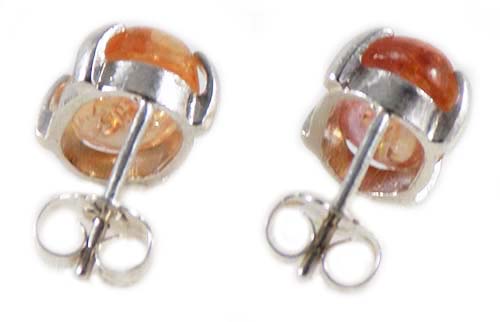 ABOUT US: Prior to our retirement we used to travel to Eastern Europe and Central Asia several times a year seeking antique gemstones and jewelry from the globe’s most prolific gemstone producing and cutting centers. Most of the items we offer came from acquisitions we made in Eastern Europe, India, and from the Levant (Eastern Mediterranean/Near East) during these years from various institutions and dealers. Much of what we generate on Etsy, Amazon and Ebay goes to support worthy institutions in Europe and Asia connected with Anthropology and Archaeology. Though we have a collection of ancient coins numbering in the tens of thousands, our primary interests are ancient/antique jewelry and gemstones, a reflection of our academic backgrounds.
ABOUT US: Prior to our retirement we used to travel to Eastern Europe and Central Asia several times a year seeking antique gemstones and jewelry from the globe’s most prolific gemstone producing and cutting centers. Most of the items we offer came from acquisitions we made in Eastern Europe, India, and from the Levant (Eastern Mediterranean/Near East) during these years from various institutions and dealers. Much of what we generate on Etsy, Amazon and Ebay goes to support worthy institutions in Europe and Asia connected with Anthropology and Archaeology. Though we have a collection of ancient coins numbering in the tens of thousands, our primary interests are ancient/antique jewelry and gemstones, a reflection of our academic backgrounds.
Though perhaps difficult to find in the USA, in Eastern Europe and Central Asia antique gemstones are commonly dismounted from old, broken settings – the gold reused – the gemstones recut and reset. Before these gorgeous antique gemstones are recut, we try to acquire the best of them in their original, antique, hand-finished state – most of them originally crafted a century or more ago. We believe that the work created by these long-gone master artisans is worth protecting and preserving rather than destroying this heritage of antique gemstones by recutting the original work out of existence. That by preserving their work, in a sense, we are preserving their lives and the legacy they left for modern times. Far better to appreciate their craft than to destroy it with modern cutting.
 Not everyone agrees – fully 95% or more of the antique gemstones which come into these marketplaces are recut, and the heritage of the past lost. But if you agree with us that the past is worth protecting, and that past lives and the produce of those lives still matters today, consider buying an antique, hand cut, natural gemstone rather than one of the mass-produced machine cut (often synthetic or “lab produced”) gemstones which dominate the market today. We can set most any antique gemstone you purchase from us in your choice of styles and metals ranging from rings to pendants to earrings and bracelets; in sterling silver, 14kt solid gold, and 14kt gold fill. When you purchase from us, you can count on quick shipping and careful, secure packaging. We would be happy to provide you with a certificate/guarantee of authenticity for any item you purchase from us. There is a $3 fee for mailing under separate cover. I will always respond to every inquiry whether via email or eBay message, so please feel free to write.
Not everyone agrees – fully 95% or more of the antique gemstones which come into these marketplaces are recut, and the heritage of the past lost. But if you agree with us that the past is worth protecting, and that past lives and the produce of those lives still matters today, consider buying an antique, hand cut, natural gemstone rather than one of the mass-produced machine cut (often synthetic or “lab produced”) gemstones which dominate the market today. We can set most any antique gemstone you purchase from us in your choice of styles and metals ranging from rings to pendants to earrings and bracelets; in sterling silver, 14kt solid gold, and 14kt gold fill. When you purchase from us, you can count on quick shipping and careful, secure packaging. We would be happy to provide you with a certificate/guarantee of authenticity for any item you purchase from us. There is a $3 fee for mailing under separate cover. I will always respond to every inquiry whether via email or eBay message, so please feel free to write.
